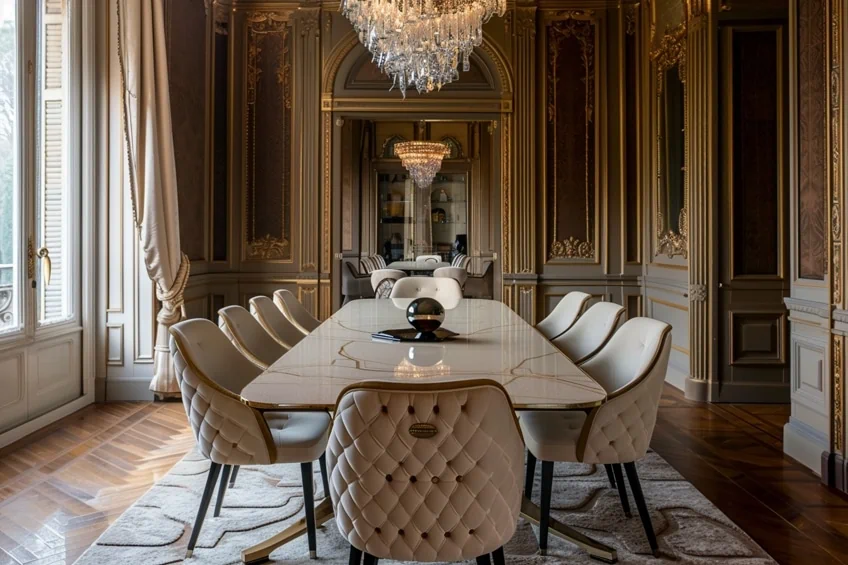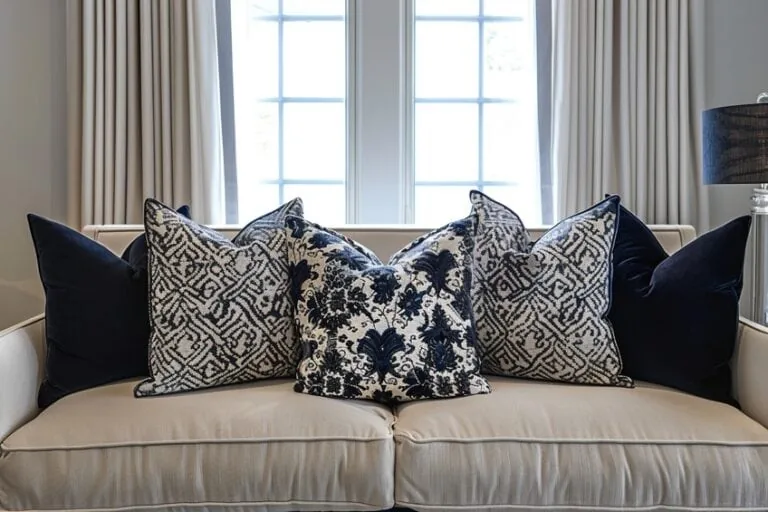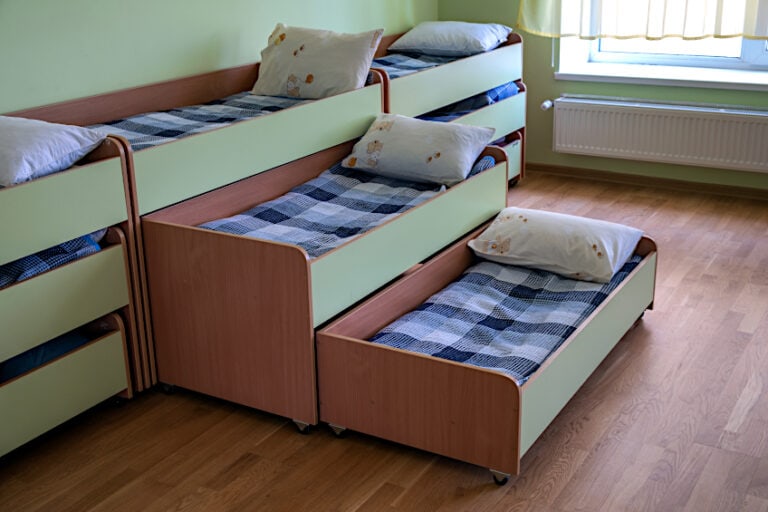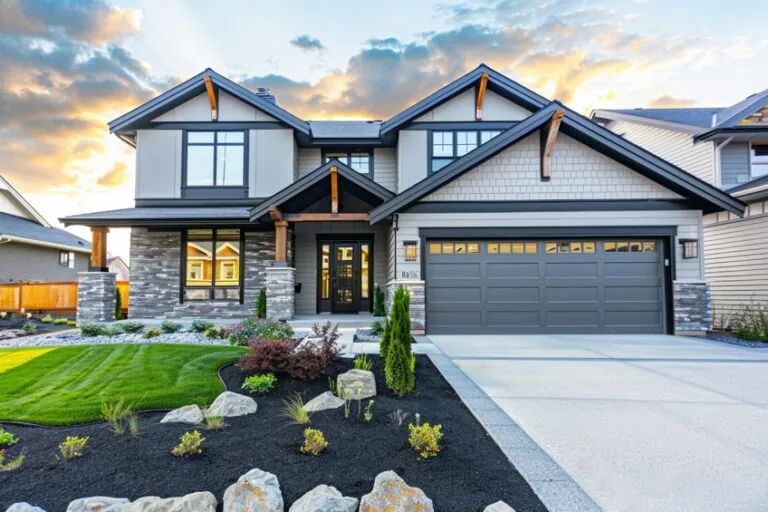Dining Table Size – How to Pick the Right Size
This post may contain affiliate links. We may earn a small commission from purchases made through them, at no additional cost to you.
Welcome to the world of dining table dimensions, where size truly matters—well, at least when it comes to hosting the ultimate dinner party or cozy family gathering! Picture this: a table that’s just right, neither too small to cram your culinary creations nor too large to feel like you’re dining in a banquet hall. Finding the perfect dining table size is like Goldilocks discovering the ideal porridge—it’s all about that sweet spot. So, let’s pull up a chair, grab a fork, and delve into the delightful realm of dining table sizes!
Contents
Key Takeaways
- Dining table size is fundamental for comfort and room flow, dictating seating capacity and fit within the space.
- Correct measurements and clearances are essential for selecting the proper table dimensions.
- Table shape, style, and material influence both actual space used and visual space occupancy.
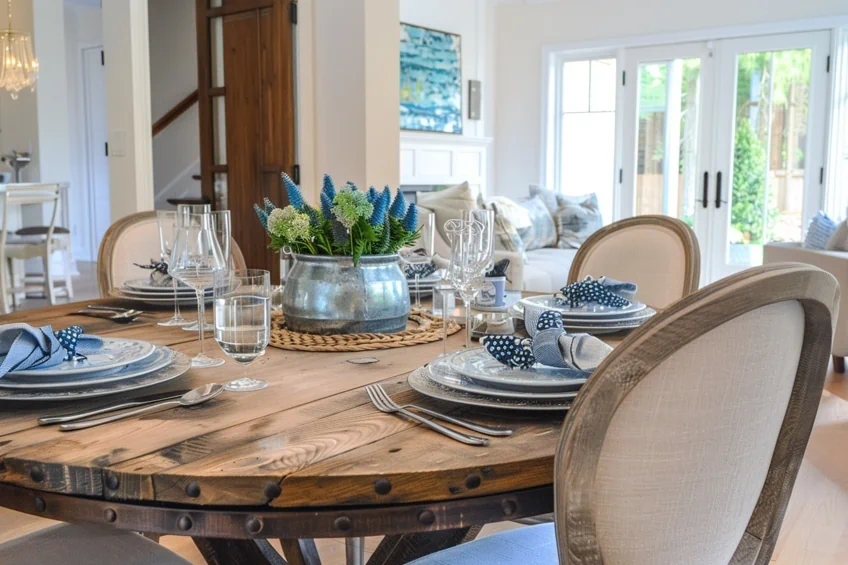
Determining Dining Table Dimensions
Selecting the right dining table involves more than style preferences; it requires understanding the interplay between table size, room dimensions, and dining needs.
Considerations for Table Size and Room Size
The size of the dining area sets a limit for the table dimensions one can accommodate. As a guideline, at least 3 feet of clearance should be provided on all sides of the table to allow enough space to walk around and to pull out chairs comfortably.
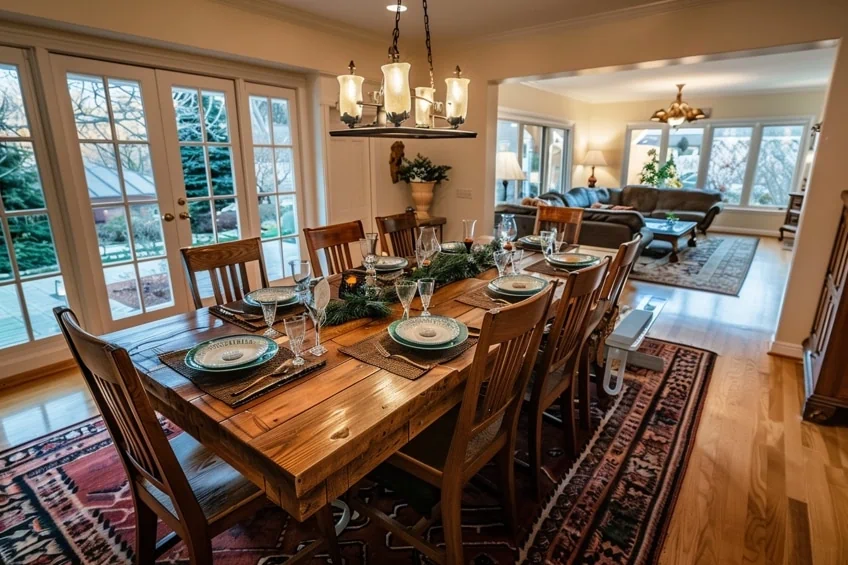
Standard Measurements and Height
Most dining tables stand at 28 to 30 inches high, aligning with the height of kitchen countertops. This standard dining table height ensures a comfortable dining experience.
Table Shapes and Their Impact on Seating
Various table shapes play a significant role in determining the seating capacity and the flow of a dining room. The classic rectangle shape, a staple in many households, seamlessly fits into most room configurations, offering practicality without compromising style. On the other hand, round tables exude a cozy charm and encourage lively conversation, yet they necessitate more central floor space, inviting guests to gather around in intimate circles. Whether opting for the versatile rectangle or the convivial round, the choice ultimately shapes the ambiance and dynamics of your dining space, adding flair to every mealtime gathering.
| Shape | Seating Capacity | Typical Dimensions |
|---|---|---|
| Rectangle | 4 people | Length: 48 inches; Width: 36-40 inches |
| Rectangle | 6 people | Length: 60 inches; Width: 36-40 inches |
| Rectangle | 8 people | Length: 78 inches; Width: 36-40 inches |
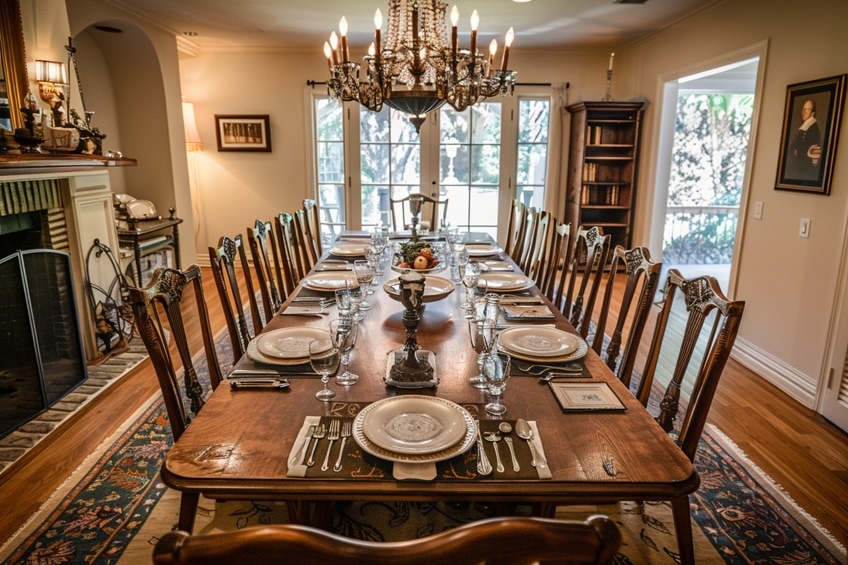
Extendable Dining Tables
Extendable tables provide flexibility for those who need to accommodate extra guests occasionally. When fully extended, one must also account for the additional room size to maintain the necessary clearance.
Styles and Materials for Dining Tables
The dining table is not just for meals; it reflects personal style and complements the home’s decor. Key factors to consider include table shape and the material it’s made from, each bringing its own aesthetic and functional qualities to the dining space.
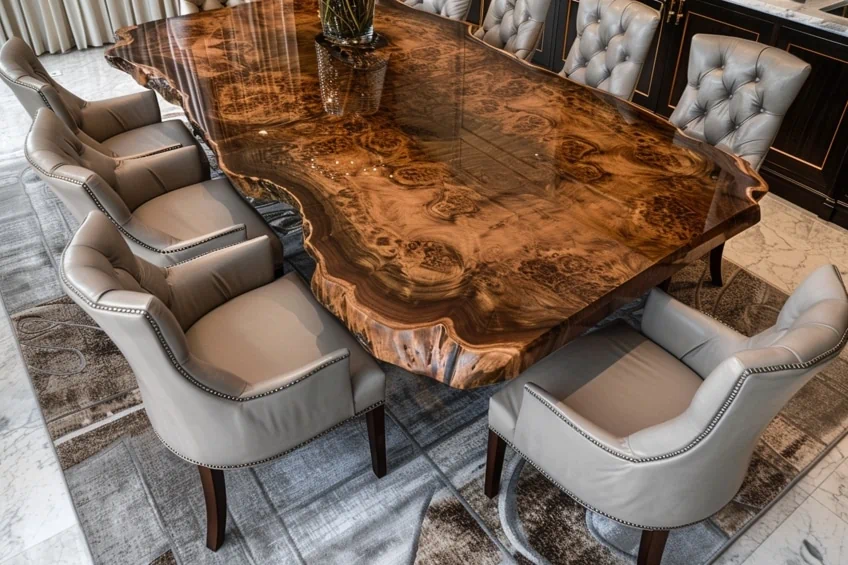
Choosing the Right Style for Your Space
When selecting a dining table style, the shape of the table should be harmonized with the room’s layout. Square tables work well in compact or square rooms, offering an intimate dining experience. Rectangular tables are versatile and fit comfortably into most room layouts, making them a popular choice for many homes.
Round tables foster a sense of closeness and are ideal for smaller groups, while oval tables can offer the same advantages as round ones but fit better in elongated rooms.
The style of the table—from traditional and antique to modern and farmhouse—sets the tone for the dining room. They can range from the ornate designs of antique styles to the clean lines of modern aesthetics, and from the sturdy, earthy presence of a farmhouse table to the more formal approach seen in some contemporary designs.
Material Considerations for Dining Tables
Materials profoundly impact both the look and durability of dining tables. Wood is a traditional choice that offers warmth and a variety of finishes, from the rustic charm of rough-sawn pine to the elegance of polished mahogany. Glass tables add a sleek, modern touch and can help small spaces feel more open but require regular cleaning to maintain their sparkle. Wood boasts durability, warmth, and a diverse range of types, making it a timeless choice with broad appeal in interior design.
Its natural charm adds a cozy atmosphere to any space, creating a welcoming environment for gatherings and everyday use.
In contrast, glass tables exude sleekness, amplifying light and enhancing the sense of openness in a room. However, they require frequent cleaning to maintain their pristine appearance. Whether opting for the enduring allure of wood or the modern elegance of glass, each material brings its own unique character to the table, shaping the ambiance of your living space.

Other materials include metal, which provides an industrial look and is highly durable, and marble, known for its premium feel and unique patterns. Less common materials such as laminate and tile offer unique textures and styles for those looking to make more personalized decor statements. It is important to consider the practicality of the material; for example, certain woods and metal may be more resistant to wear and easier to maintain than glass or marble.
Choosing the Right Size Table For Your Room
When selecting a dining table, the guiding principle is to ensure ample space for movement and comfort. A balance between table size and room dimensions is imperative.
Seating Capacity
When considering room size, remember to allow for approximately 3 feet of clearance around the table to pull out chairs comfortably and enable guests to move around without restrictions.
- Small tables: For a dining space that needs to accommodate up to four people, tables measuring around 36 to 44 inches in diameter for round shapes, or 36 inches wide and 48 inches long for rectangular options are sufficient.
- Medium tables: A table for four to six people should be about 60 inches long and 36 to 40 inches wide. For oval and round tables, aim for 48 inches in diameter.
- Large tables: Groups of six to eight require tables that are at least 72 inches long and 36 to 40 inches wide. For round tables to seat this many, at least 60 inches in diameter is optimal.

Measuring and Spacing Guidelines
Selecting the right dining table involves more than just aesthetics; it requires practical considerations of space and comfort. Below are steps aimed at ensuring a functional dining area.
Measure the Room Where Your Table Will Go
Before purchasing a dining table, measure the length and width of your dining space. This is critical to ensure the table will fit comfortably. An easy method is to use a measuring tape to ascertain the dimensions of the room where the table will be placed.
Leave Adequate Space Around Your Table
It is essential to maintain a clearance of at least 36 inches around the perimeter of the table to allow for smooth movement. Ideally, aim for 24 inches of space per person seated at the table, ensuring guests can sit and stand without hindrance.
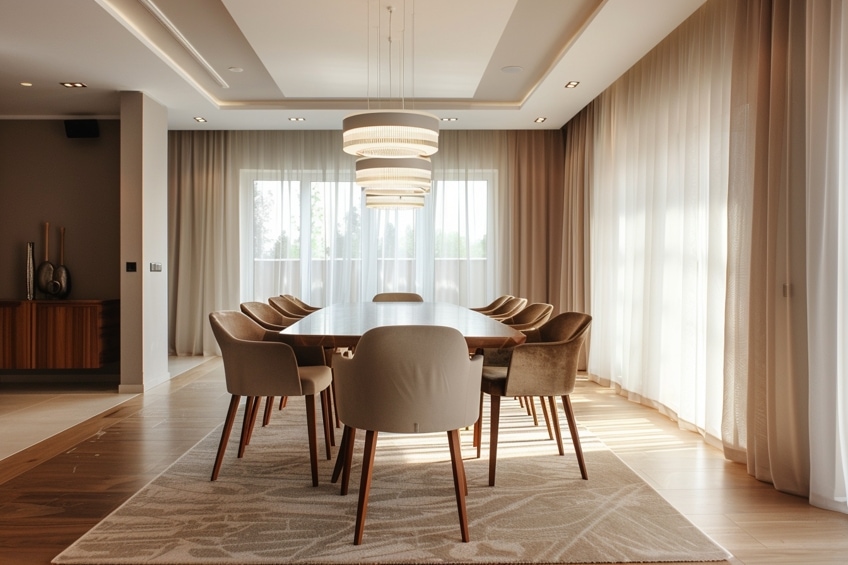
Consider Light Fixtures Above Your Table
The position and size of light fixtures can affect both the table placement and size. Ensure that any overhead lighting is centered above the table and is proportionate to the table’s dimensions for balanced illumination.
Moving the Table In
Remember to account for doorways, staircases, and any turns into the room when moving your dining table in. Ensure there is a clear pathway that accommodates the table’s dimensions, with a few inches of clearance to avoid damage during the move. By following these precise guidelines, one can choose the right table size that is in harmony with the dining space.
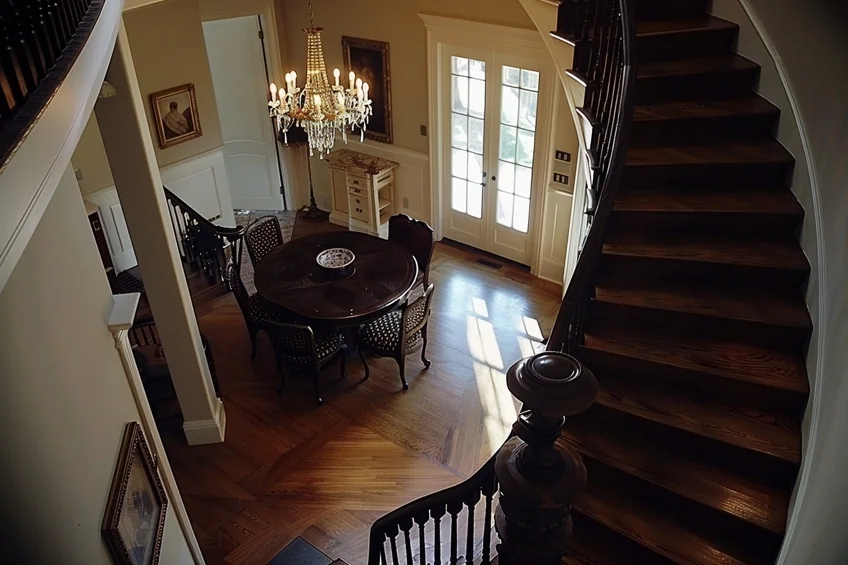
As we bid adieu to our exploration of dining table sizes, remember: finding the right fit isn’t just about measurements; it’s about creating memories and fostering connections. Whether you’re hosting a lavish feast or enjoying a cozy dinner for two, let your dining table be the centerpiece of laughter, good food, and cherished moments. So, go ahead, embrace the joy of choosing the perfect size, and let your dining adventures unfold with style and flair! Cheers to many more delightful gatherings around the table!
Frequently Asked Questions
How Large Should a Dining Table Be to Comfortably Seat Six People?
A dining table that seats six people should be approximately 60 inches long and 36 inches wide. An individual requires about 24 inches of space in width to dine comfortably, ensuring everyone has enough elbow room.
How Do You Calculate the Appropriate Dining Table Size for a Space?
To calculate the appropriate dining table size for a space, ensure there is a clearance of 36 to 42 inches between the table and the walls or any other furniture. This allows for sufficient room to move chairs and walk around the table. Measure the dining area and subtract the clearance space to determine the maximum table dimensions that will fit comfortably.


